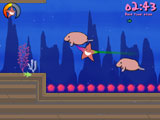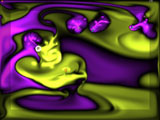The Squishiest Damn Starfish Around
Squishy the Starfish is a great student project out of Digipen. Like many student projects, it’s a little rough around the edges, but it manages to pull off a decent implementation of a neat concept. The team describes the game as:
Squishy the Starfish is a 2D side-scrolling environmental puzzle game. Making use of Squishy’s unique ability to extend his five elastic arms, the player must swing, climb, and maneuver throughout the underwater world.
Controls (Old vs. New)
While Squishy the Starfish does bring a nice twist to the genre with the five-armed starfish treatment, a swinging physics game is nothing new. The real test of a swinging game lies in the controls, though. It’s dangerous territory as a designer; the line between “novel” and “frustrating” is awfully thin. Squishy does a good job addressing some of the problems of a multi-rope swinging mechanic with its mouse-only controls.
I actually installed Squishy the Starfish months ago but just didn’t get around to reviewing it. When I sat down to play it today, I was playing that old version (and even produced a video for it). I didn’t realize there was a newer version until I went to get the link for my review. The old controls were frustrating as hell. You moved with WASD, and had to actually highlight the connected tentacle arm to adjust its length. It was touchy at best.
This version of Squishy exclusively uses the mouse, and I think that was a very wise choice. I’m especially impressed by their elegant solution for disconnecting old “ropes”. Right-click disconnects the arm farthest away from the starfish’s body. And since you move towards the mouse cursor, the farthest arm is generally the one you really want to disconnect, particularly if you’re swinging across the ceiling arm-over-arm. It’s great to see that the team was able to recognize problems with the old controls and address them.
Physics Simulation
The simulation component of Squishy the Starfish is a little twitchy. It’s always hard to pin down the “feel” of a physics engine, but something about Squishy feels too jittery. I think if the main character felt heavier, and had more dampening, it wouldn’t be so difficult to keep your momentum up. As is, it’s hard to get into the flow of smoothly navigating through the level.


(Squishy the Starfish Game Screenshots)
Free Undersea Adventures
Squishy the Starfish weighs in at three levels, so it’s really more of a portfolio piece than a game. The three levels differ in pacing and style, though. The developers did a good job embellishing their control mechanic with various props and situations. With a bit of love, Squishy could turn into a great physics platformer (well, except for the small fact that Digipen–not the students–owns the project).
Squishy is a solid implementation of a slick concept for a physics game. It’s a little unpolished, probably due to the time constraints of being a student project, but it’s a great student project. Hell, I’d hire them.
Download Squishy the Starfish Game (16.4 MB)
(Link takes you to Digipen’s gallery page, as the school prohibits redistribution).
Related Posts:
Viscous Fun in this Fluid Dynamics Physics Game
Ichor is an experimental physics game by Soylent Software. The developer’s concise description of the game does an excellent job, so I’ll just paste that:
Ichor is an action game based in fluid dynamics. Each player floats around the screen, trying to engulf his opponent with his own color.
Fluid Exchange
The beauty of Ichor is the simplicity of its structure. It immediately becomes obvious that if you touch the other color, you lose, and the goal is to cause opponents to touch your color. Basic movement keys represent the totality of the player input (mouse for single player, keyboard for two-player duels). It’s a very straightforward setup.
The actual experience of playing Ichor is much more complex, though. There are numerous strategies for “attacking” enemies. You need to be keenly aware of the fluid’s behavior. Aligning yourself upstream from an opponent and moving with a current will be much more effective than blindly bum rushing the nearest target. I found that, over time, my awareness of the fluid’s state became more complete and useful in making second-to-second decisions.
Objects to Think With
Ichor is fairly quirky, even for an indie game. I was curious about the intent of the developers, and after some research I found myself on the blog of the (sole?) developer, Namaste Reid. He makes an interesting observation about the lack of many distinct objects in the game:
In Ichor, you fight without bullets or guns. You are just there, in the fluid. Everything is subject to change at a moments notice. Compare this to games where you have units, terrain, weapons, textures, etc. These are all easily classifyable objects. I think that I can go further than Ichor, in countering object oriented gameplay, although I’m not sure it can be done with fluid dynamics alone. If it is possible, it will need to be a game where nothing isn’t fluid. I’ve been trying for a while, and have yet been unable to come up with a game design that is more purely fluid than the duel mode in Ichor.
Free, and Source Available!
Ichor’s single player game is actually rather difficult; the average game only lasts a few minutes. Still, there’s something about the game that insists you try just one more time. It’s definitely more of a high-minded experience than something like a hurt-the-ragdoll title, but if you approach it with the right mindset it can be a fun way to kill a few minutes.
Download Ichor Game (777 KB)
(be warned–the developer recommends a 3Ghz machine or faster)
The source code for Ichor and Soylent other titles are available from the Soylent Software website.
Related Posts:
Fun-Motion Featured in The Wall Street Journal!
Aaron Rutkoff’s latest Time Waster column in The Wall Street Journal Online is all about Fun-Motion. I find this to be rather amazing. Aaron contacted me earlier this month about doing an interview; we talked on the phone and followed up with an email exchange. The output of his type-wizardry is available to you now!
Read the Fun-Motion WSJ article here.
p.s. Expect a flurry of new reviews and interviews soon!






 My name is Matthew Wegner, and this site is dedicated to physics games.
My name is Matthew Wegner, and this site is dedicated to physics games.